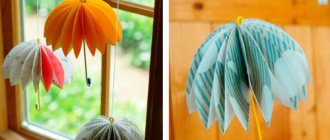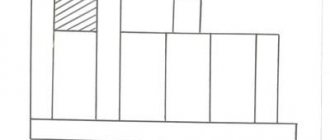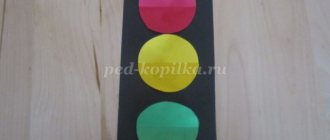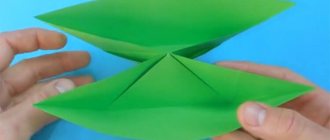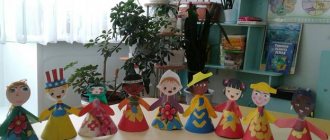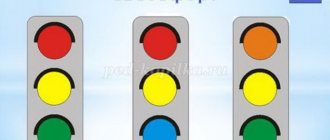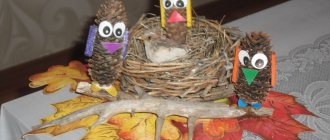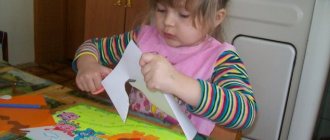A selection of games on the topic “Road Rules” for children of middle preschool age (4-5 years old)
A selection of games on the topic “Road Rules” for children of middle preschool age (4-5 years old)
Author: Furtuna Ekaterina Sergeevna
Educator of GBOU school No. 569 of the Nevsky district of St. Petersburg, structural unit of the department of preschool education for children. Saint Petersburg
In the daily life of preschool children, play activities occupy a central place. They gain any knowledge through the game, directly participating in it. Thus, it would seem that practical knowledge of traffic rules and safe behavior on the road as a pedestrian and public transport passenger is given to children through observations, explanations, and the personal example of adults, but this is not entirely true - children also acquire this information and experience, mainly , through play activities.
Outdoor games:
"Find your color"
Goal: develop the ability to navigate in space, learn to act on a signal, develop attention.
Children are given red and green flags. Option 1:
Cubes of the same colors are placed in different places in the group.
The children disperse into the group. At the teacher’s signal “Find your color,” children must find a cube of the same color as the flag in their hands and approach it. Option 2:
The teacher has circles of the same colors. Children walk around the group, when the teacher raises one or another circle, the children need to match its color with the color of the flag in their hand, and only those children whose flags match the color of the circle in the teacher’s raised hand run up to the teacher.
"Find your car"
Goal: develop the ability to navigate in space, learn to act on a signal, develop attention. In different places of the group there are chairs with red, green and yellow cars attached to them. Children have circles of the same colors. Children walk around the group - the “city”, and at a signal (any signal - a voice, clap) they run to their car (the same color as the circle).
"Sparrows and the car"
Goal: to develop the ability to navigate in space, move in different directions, learn to respond to a signal in a timely manner, and develop attention. Children are located on one side of the group or on an area on the street - these are “sparrows” in nests. On the opposite side is the teacher (in the future you can offer this role to the child) - the “car”. At the teacher’s signal, “The sparrows have flown,” children run around the entire space, waving their arms (wings). At the signal “Car” the sparrows run away to their places.
“Act on signal!”
Goal: to develop children’s attention and skills to respond correctly and quickly to traffic lights. Children stand in a row on one side of the group or playground. The teacher (depicts a “traffic light”; in the future the role may be played by the child) has two circles – red and green. Children are asked to run to the opposite side and back, but at the same time, paying attention to the traffic lights: green - run, red - stop.
“Traffic light signals” (“Traffic light”)
Goal: to develop children’s skills to correctly respond to traffic light signals and compare their actions corresponding to each of the signals. The teacher has circles of red, yellow and green colors. Children sit on chairs. Depending on which circle (traffic light) the teacher shows, the children do the appropriate actions: on green - they walk in place, on yellow - they clap their hands, on red - they sit.
"Colored Cars"
Goal: to consolidate knowledge of primary colors, continue to develop the ability to navigate in space, move in different directions without colliding with each other, learn to act on a signal, and develop attention.
Children are given color models (templates) of cars. The teacher has circles of the same colors (then the role is transferred to the child). Children stand on one side of the group or playground (in the garage) and wait for the appropriate signal. Depending on which circle rises, those cars (of the same color) move in the group. When the circle lowers (or hides behind the back), these cars go back to the garage, and cars of the same color as the raised circle leave. Variations:
You can use verbal cues instead of circles.
Didactic games:
"Assemble a traffic light"
Goal: develop attention, memory; train the skills of laying out a paper object on a plane. On command, children must quickly and correctly assemble a traffic light model from the proposed parts (rectangle, circles of corresponding colors).
cut-away pictures “Fold the transport from parts”
Goal: to consolidate children’s knowledge about types of transport and its parts, to develop memory, coordination of movements, and thinking. Each child receives a card with drawings of parts of transport and independently puts together one or another type of transport from the parts, names it, says what it is needed for. The winner is the one who puts the picture together faster and names it.
"Find the same sign"
Goal: to train children’s knowledge of the name and purpose of road signs familiar to them, to develop intelligence. The teacher distributes cards with images of signs to the children and keeps a second set of the same cards for himself. Next, the teacher shows one of the cards, the child, having found the same sign, must raise the card and say: “I have the same sign _____ (name of the sign).”
“What is the hidden sign?”
Goal: develop visual memory, consolidate knowledge of road signs. The teacher lays out (exhibits) several road signs known to the children, and repeats their names along with them. Children close their eyes or turn away, and the teacher at this time removes one sign. Children must guess which sign is hidden.
“Wonderful bag - types of urban transport”
Goal: To continue to develop children’s ability to describe objects and objects, starting with their names, developing the ability to coordinate words in a sentence by gender, number, case, using prepositions correctly. The teacher is holding an opaque bag (“wonderful”) with different models of types of urban transport. Children sit in a semicircle and in a circle so that everyone can see each other. The teacher brings the bag in turn to each child, who puts his hand in and takes out one of the models. Having taken out the model, the child must name the model and tell what this vehicle is intended for.
Role-playing games:
"Bus" ("Tram")
Goal: Consolidation of knowledge and skills about the work of a driver and conductor.
Familiarity with the rules of behavior in public transport. Formation of positive relationships between children. Foster respect for the professions of driver and conductor. The chairs are arranged in the same way as the seats in a bus (tram), with the conductor's seat in the back and the driver's seat in the front. Drivers can choose from a child using a rhyme and give him the steering wheel. Children are given imaginary money to buy tickets, and the conductor gives them tickets. The conductor invites passengers to board the bus and sit in the empty seats. The conductor then hands out tickets and announces the next stop (this could be play corners or group areas). “Ride the Bus”
Purpose: to familiarize children with the rules of conduct on public transport, to develop friendly relationships with peers, and to develop the ability to assign roles. The teacher invites the children to build a bus from chairs in a group, choose a driver (you can use a counting rhyme) who will be in the cab. The remaining children will be passengers. The bus will make stops at the stations “Stroitelnaya”, “Knizhnaya”, “Zoo” - corresponding to the play areas in the group. Children will have to enter the bus through the back door and sit on chairs (seats on the bus), not forgetting to buy a ticket from the conductor, and get off at stops through the front door.
Moving exercises:
"Building a house"
One two three four five.
(standing, hands on waist, turns left and right)
We will build and play.
(squats are performed rhythmically)
We are building a big, tall house.
(stand on your toes and stretch your arms up)
We install windows and build a roof.
(jumping in place)
What a beautiful house!
(extend your arms forward with an index gesture)
An old gnome will live in it.
(sit down)
. (N. Nishcheva)
"Truck"
The truck is carrying sand.
(walk in a circle, pretending to twist the steering wheel)
The people are surprised:
(stop facing the circle, spread their arms, make a surprised face)
“This is such a miracle, miracles,
(tilt your head left and right twice)
There is sand in it to the heavens!”
(stretch on your toes. Raise your arms up).
(N. Nishcheva)
"Sprinkler"
This “cloud” on wheels
(walk in a circle, one after another, depicting
Rain driving through the city.
twisting the steering wheel)
The roads will become clean,
(walk in a circle, one after another, depicting
If a cloud falls on them.
sweeping the road with a broom)
(N. Nishcheva)
"Chauffeur"
I'm swinging and flying at full speed.
(run in a circle and turn the imaginary
I myself am the driver and I myself am the engine.
The steering wheel)
I press the pedal -
(stop, press the imaginary pedal with my right foot)
And the car rushes into the distance.
(and run in the opposite direction)
(N. Nishcheva)
Literature:
- From birth to school. Approximate basic general education program for preschool education / Ed. N.V. Veraksy, T.S. Komarova, M.A. Vasilyeva. – M.: Mosaic-synthesis, 2010.
— Role-playing games for preschool children / N.V. Krasnoshchekova. – Rostov n/d.: Phoenix, 2006.
— Didactic games in kindergarten. Book for kindergarten teachers / A.K. Bondarenko. – M.: Education, 1991.
— Nishcheva N.V. Card index of outdoor games, exercises, physical education minutes, finger gymnastics. – St. Petersburg: Detstvo-press, 2009. – (Speech therapist’s office).
